The Rusty Nail is the ultimate Scotch Cocktail. The high-proof drink is made of two ingredients, Scotch and a Scotch liqueur called Drambuie. Sounds too one-dimensional? Well, it doesn't have to be.
The drink is simple yet elegant, and we show you how you get it right.
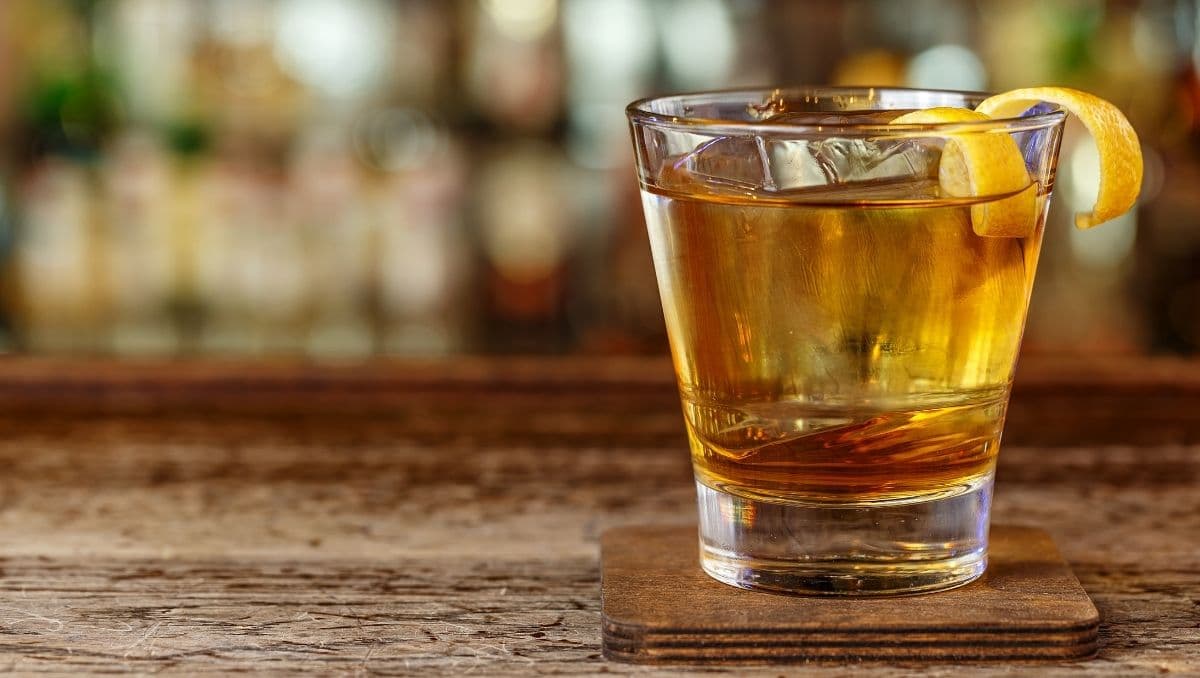
With this straightforward two-ingredient cocktail, there is nowhere to hide. The key to making it is fine Scotch Whisky and Drambuie.
Whisky: The Scotch should be of good quality as it will ultimately define if the cocktail is a hit or miss. You can experiment with different types and levels of peatiness. The crucial part here is that it suits your palate. If you're unsure, read our guides about the different Scotch types and regions - including recommendations.
Drambuie: Drambuie is surely the most distinguished Scotch liqueur and an absolute must for this cocktail. The name is the Gaelic term for a drink that knows how to satisfy your tastebuds. It offers the perfect level of sweetness and a very complex flavor profile. It's super smooth with hints of slightly spiced honey, anise, orange, and oak.
Apart from the right choice of Scotch, the preparation method play a vital role in getting the Rusty Nail right. As you may know, the rule says that drinks containing only alcoholic components are stirred, not shaken, and this is no exception.
Scotch and Drambuie both are high proof with an ABV of 40% - or potentially slightly above in the case of the whisky. Thus, you need dilution from the ice.
For this, fill your mixing glass to the rim with ice cubes. Stir with a bar spoon for at least 20 seconds or 50 rounds. A little more might be even better in that case. -We usually stir our Rusty Nail for 25 to 30 seconds.
Now, you should have the perfect level of dilution (ca. 10ml or 0.35 oz of ice-cold water). Serve it with a large, clear ice cube that keeps the drink cool but melts slowly.
Garnish your Scotch Cocktail with a lemon peel. - For the final touch, hold it over the drink and squeeze it together to release some of the essential oils before discarding it into the glass.
The drink seemingly came out of nowhere and went the same way. Cocktail historians like David Wondrich think the earliest forerunner went under the name B.I.F., a reference to the British Industry Fair, [1], and was created by one Mr. F. Benniman in 1937.
Later on, the same recipe went under the names "D&S" and "Little Club #1" and some others. Then suddenly, in the 1960s, Rusty Nail came up and stuck. Who had the idea is unfortunately unknown.
In the 60s, "Have you tried a Rusty Nail?" was a frequent question in many bars. Of course, it made customers curious. What is it? How does it taste? Et voila, that was another Rusty Nail ordered.
The cocktail remained a favorite in bars for ages. Yet, eventually, time took its toll, and the once oh-so-famous concoction was forgotten - until the recent return of vintage craft cocktails and the increasing interest in mixology.
If you want to try more cocktails made with Scotch, how about some of these classics:
The recipe of the Martinez Cocktail laid the grounds for many of today's famous cocktails, amongst them the classic Dry Martini.
Despite - or perhaps thanks to its many prominent descendants, the Martinez itself is still a winner on every bar menu. It consists of equal parts gin and sweet vermouth, mixed with Maraschino liqueur and a dash of cocktail bitters.
You can find recipes for different variations of the Martinez (some listed below), but here's the original, also in line with the International Bartending Association IBA.

The Martinez is an elegant composition of gin, vermouth, Maraschino liqueur, and cocktail bitters. With a boozy mix like this, you want to pay attention to detail when picking your ingredients:
We recommend using either Old Tom or London Dry Gin for your Martinez. The first will get you a slightly sweeter drink, while the second creates a drier version.
To get your perfect Martinez cocktail, you should pick a gin that suits your palate. Jerry Thomas - most likely the inventor - asks for different types of gin in his various recipes for the cocktail.
Two of them were of English origin, but in his first version, he asks for domestic gin and seems to have been referring to Genever.
Either way, today's Gin selection is not comparable to what it was back then. Nowadays, there are so many types of gin, and picking one can be a challenge.
If you want to take a traditional approach, try malty Genever. It sits somewhere in-between Old Tom (slightly sweeter) and London Dry (drier and more juniper-forward). But you can also experiment with more citrus-forward or floral gins as they also work with vermouth and Maraschino.
The Martinez is stirred and served straight up, so no ice is in the glass. If you follow these tips, your drink will be as good as in your favorite cocktail bar:
The classic version of the cocktail uses only sweet vermouth. More modern interpretations can include a combination of dry and sweet vermouth, like the recipe from Simon Diffords. Others even substitute it with Curaçao or Cointreau.
You can also experiment with a Genever base instead of the classic Gin base. This combination works remarkably well, delivers a well-balanced drink, and picks up an early approach to the cocktail.
By the way, if the recipe for the Martinez feels familiar, that makes a lot of sense. In fact, the Gin-based drink is a variation of the Manhattan Cocktail.
The first time the Martinez cocktail recipe was published in written form was in 1884. O.H. Byron included it in his "The Modern Bartender's Guide". Yet, he did not provide a recommendation regarding the type of gin. Most likely, it was an Old Tom Gin or a Genever, as both were quite common at the time.
It might well be that O.H. Bryon also invented the drink. However, historians suspect the cocktail is at least a few years older. In fact, there are rumors that legendary Jerry Thomas might have created it.
If that is the case, the birth of the Martinez probably was after 1876, the year Jerry Thomas published his famous book The Bartender's Guide. This first edition didn't include the Martinez, but the reissue almost ten years later did.
After Jerry Thomas died in 1885, an updated version of his book got published. In this and later version of The Bartender's Guide, you can find a recipe for the Martinez cocktail. - An indication that Jerry Thomas might indeed be the original creator of the classic Martinez cocktail.
Of course, that doesn't prove he invented the drink, as it got printed shortly after O.H. Bryon's book. But still. Also, Jerry Thomas' recipe is very close to those served in today's bars.
For the vermouth part, Jerry Thomas presumably used sweet vermouth in his recipe. However, his book only says vermouth without further specification, which led to speculation and some variations mentioned above.
Like all Fizz cocktails, the Gin Fizz recipe is closely related to Sour and Collins Cocktails. Still, there are some small but noteworthy things that -in mixology- make all the difference.
Quick Facts Gin Fizz Cocktail
Now, before getting into detail about mentioned differences, let's look at the Gin Fizz recipe and the cocktail in general.
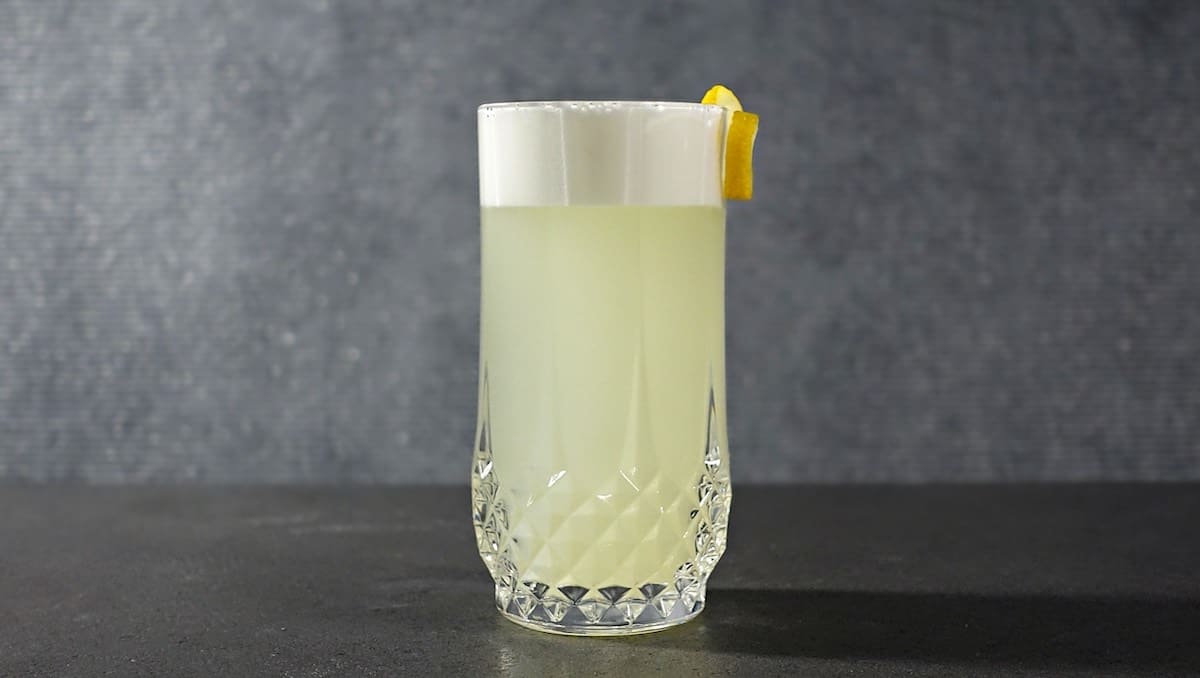
Here's everything you need to make the classic Gin Fizz Cocktail to perfection:
The egg white adds texture to the drink. It's not only the frothy top, but the whole cocktail obtains a smooth mouthfeel. Yet, the original recipe didn't include egg white, and also today, a Gin Fizz often goes over the bar counter without.
Some people just don't like the idea of raw egg white in a drink because they are concerned about the health risks. If you're reluctant to use egg, let me tell you that it is harmless. The alcohol kills most bacteria, and the lemon juice is also "cooking" the egg white.
However, if you're vegan or don't want or cannot consume eggs for other reasons, there's a perfect alternative called Aquafaba.
To get the best out of this classic recipe, you should consider a few things when preparing the gin cocktail:
For example, you can let your fresh lemon juice age for a short while. Sounds contradictory? It's not. Aging lemon juice means squeezing your lemon and letting the fresh juice sit for 4-10 hours. Due to a biochemical reaction, it will lose some of its bite and give the cocktail an even smoother, milder taste.
Further, to get the perfect texture, you should perform a dry shake. That's shaking your drink without ice and then with ice - or the other way around. That helps create foamy air bubbles in the egg white.
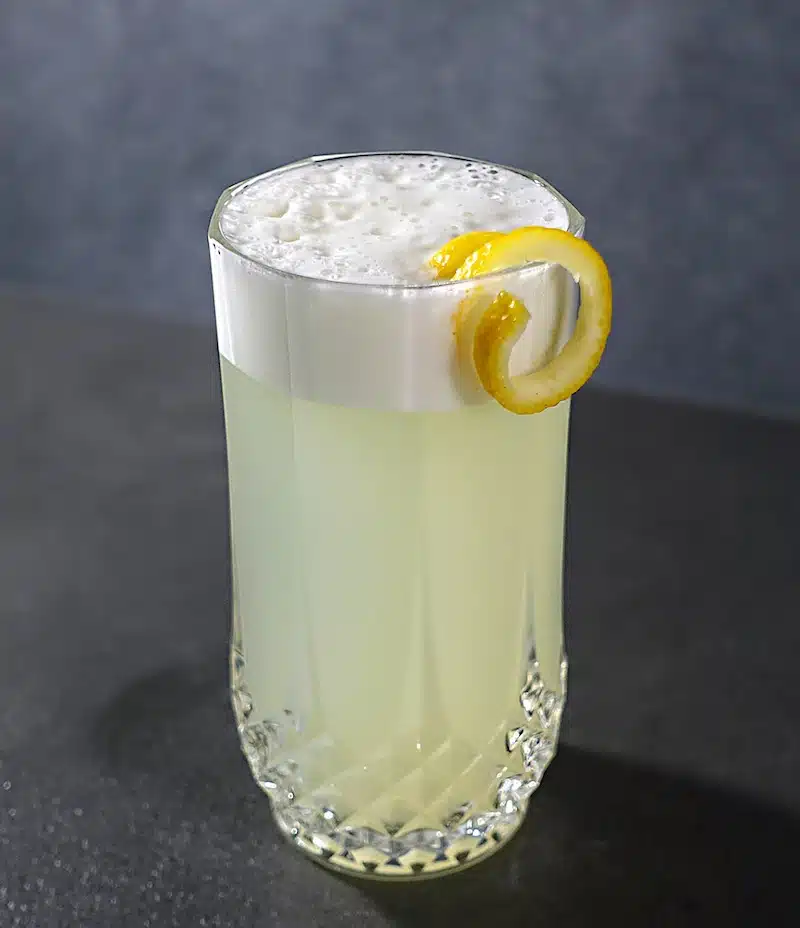
Besides experimenting with the different types of gin, you can also get creative with the syrup. The Gin Fizz leaves a lot of room to add flavor - and color.
For instance, add some beautiful subtle fruitiness or a floral aroma that will go perfectly with a floral New Western Dry Gin.
And flavored syrups can also alter the visual appearance of your Gin Fizz. For instance, with homemade hibiscus syrup or color-changing butterfly pea syrup, you can turn the cocktail pink.
If you want more inspiration, head to our section about homemade syrups for cocktails.
The main difference is that a Tom Collins is always served without egg white, whereas the Gin Fizz often has a foamy egg white top. Plus, the preparation is different, as well:
For one, the ratios are different; the Fizz contains more lemon and less soda. Further, the Gin Fizz is shaken while the Tom Collins is built directly in the glass.
Another distinction is the garnish. A Gin Fizz comes with no garnish or just a lemon twist or wheel, while a classic Tom Collins usually features a cocktail cherry. -Details that make the difference.
The first time ever that a Gin Fizz recipe got printed was in the famous cocktail book of Jerry Thomas - The Bartenders Guide. That was back in 1876, a starting point for the Fizz cocktails.
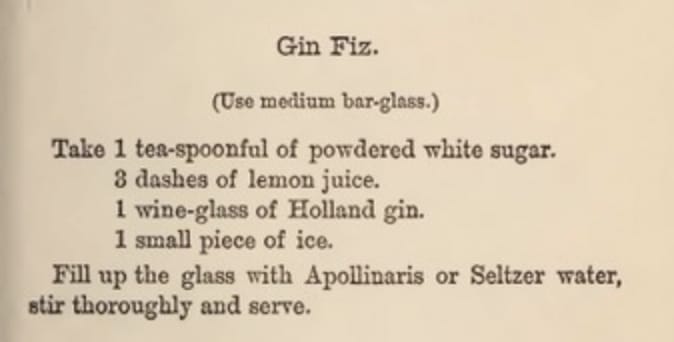
It took a few years until the cocktail gained traction. But in the early 1900s, the Gin Fizz cocktail became really popular.
Traditionally the Gin Fizz was served in a small glass with sugar and Holland Gin - referring to Genever, a predecessor of the popular spirit.
Jerry Thomas also included a version that contained egg white in the same book under the name Silver Fizz. The -for the time- unusual, new, and refreshing blend also led to many other closely related recipes.

Due to the popularity of the Gin Fizz, other famous classics like the Ramos Gin Fizz and the Sloe Gin Fizz evolved. The Ramos Gin Fizz adds heavy cream and orange flower water, while the Sloe Gin Fizz replaces regular Gin with Sloe Gin.
Another close relative is the Gin Sour. The list of ingredients is similar to the Fizz, but the recipe doesn't include soda.
Bourbon is a household term. But despite it being such a common expression, many do not know what the term Bourbon actually means - apart from it being some sort of whiskey.
Even fewer know that corn is the main ingredient or how strictly regulated Bourbon is. Also, there are parts of the world where not all Bourbon is considered whiskey - at least not officially, as it does not always fulfill the local legal requirements.
So, let's look at what Bourbon is in our guide.
Bourbon is a specific type of whiskey native to Kentucky, USA, primarily made from sweet corn. Its mash bill must consist of a grain mix with at least 51% corn. That is also the reason for its distinct sweet taste. No other whiskey offers a similar flavor profile.
That sweetness is also why cocktail recipes that include Bourbon shouldn't be made with other types of whiskey - at least if you aim for their classic taste.
Bourbon has a distinctively sweet taste coming from corn. Yet, throughout the aging process, the spirit acquires additional flavors. That can be but is not limited to vanilla, caramel, spice, and, naturally, oak.
The flavor profiles are comparable between brands, but there are still noticeable differences in taste and quality. You can experience the flavors and aromas best if you drink it neat in a type of whiskey glass designed for the purpose.
Whiskey, in general, is an amber-colored, barrel-aged spirit made of fermented grain with at least 40% vol. The most characteristic feature of Bourbon is that its mash bill must have at least 51% corn, whereas other whiskeys are mostly made of barley, rye, and wheat.
Corn is also responsible for the comparably sweet taste. Whiskey beginners might not taste a massive difference between Bourbon and other types. However, once your palate is more trained, you will definitely be able to taste the corn.
If you want to know more about the spirit in general, head over to our Whiskey Guide.
The mash bill isn't the only requirement a spirit has to meet to be called Bourbon Whiskey. There's a lot more to it. According to the US Code of Federal Regulations, CFR §5.143c (2), these are:
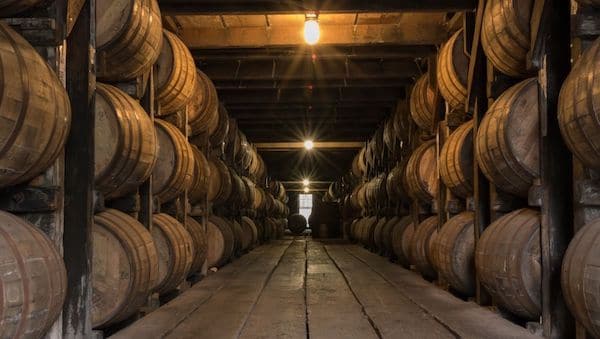
Kentucky is the home of Bourbon. Yet, even if most Bourbon is from there, it doesn't necessarily have to be. The regulation regarding the production site is that as an original American product. It has to be manufactured in the US to be called Bourbon. Hence, you could produce Bourbon in every state but not outside America!
Yet, in reality, only a few attempt to produce it even outside Kentucky. The state accounts for 95% of the global Bourbon production. There's also a sub-type called "Kentucky Bourbon". Obviously, this type has to be distilled and aged in Kentucky.
You can discern different types of the US spirit, either regarding aging time, mash bill, or the blend:
In European countries, whiskey needs to age for a minimum of three years before you can legally call it whiskey in the first place.
With standard Bourbon having no specific requirement regarding how long it must be aged, some producers stay below that three-year mark. So these Bourbons technically do not qualify as whiskey in European countries.
But no need to panic. Most popular Bourbon brands barrel-age their spirits for three years or more. If they don't, it must say so on the label.
For instance, the best-seller from Jim Beam is aged four years. Also, if you now wait for info on Jack Daniel's, that's not Bourbon, really. It's Tennessee Whiskey. You can read more about this in Jim Beam vs. Jack Daniels.
Bourbon is a classic. Back in the days when cocktails came up in the US, it was widely available and continues to be today. So, no wonder bartenders and mixologists use it in many of our favorite whiskey drinks.
It's probably most famous in drinks like

The world of mixology wouldn't be the same without Cointreau. It's a clear liqueur infused with the peels of oranges. And it also is one of the most frequently used ingredients and part of many classic cocktail recipes.
Yet, apart from the name, most people don't know too much about the orange-flavored Liqueur from France.
In a nutshell, Cointreau (pronounced "kwaan-troh") is a specific type of Triple Sec. It's a strong, intense orange-flavored, and colorless liqueur from France. The powerful orange aroma comes from the essential oils in the peel of premature oranges.
The base alcohol has a neutral flavor and is obtained from sugar beets. With 80 proof, translating to 40% ABV, Cointreau has the equal-proof Vodka in the US.
It's a premium product and typically the preferred choice when using Triple Sec. However, there's a large selection of substitutes for Cointreau.
Cointreau has a bitter-sweet orange flavor with a remarkably intensive zesty and fresh citrus aroma. Because it is so low in sugar and heavy in alcohol, the liqueur is surprisingly alcoholic and dry.
Nothing comparable existed when Cointreau's Triple Sec hit the market in the mid-1800s. Due to their meticulous production process, they created a product three times more concentrated in flavor than any other orange liqueur at the time.
Cointreau is best when served chilled. Either on the rocks as a digestif, in a light aperitif cocktail, or in classic cocktails like a Margarita or Sidecar.
In rare cases, it is also served neat. However, the aroma and taste of the liqueur in this case is particularly intense. If this is too much for you, you can also add ice cubes afterward to mute the flavors.
In cocktails and mixed drinks, Cointreau functions as a flavor amplifier adding balance, depth, and freshness while bringing out the flavors of the other ingredients.
Cointreau uses the green peel of premature sweet and bitter oranges for their Triple Sec. After carefully selecting the oranges, they hand-peel and dry those peels in the sun for three to five days.
The brand explains that doing this process by hand is crucial because the thickness and shape of the peels play an important role in the production of their orange liqueur. -They must dry evenly until they all reach a moisture content of 11%.
Once the peels are dry enough, Cointreau's master distiller ensures that the ratio of sweet to dry peels is perfect. Needless to say, the exact composition and recipe are a secret.
Neutral alcohol, the peels, sugar, and water then go together in the pot of a column copper still. In there, the peels rehydrate again for a few hours before the mash gets distilled three times. After a quality check, the finished product is filled into the iconic orange, rectangular bottle.
Due to its high alcohol content, Cointreau won't turn bad. However, aroma and flavors will fade over time. Opened bottles will last for approximately two years and unopened bottles for around five years or up to ten years. The exact shelf life is hard to predict as this always depends on how the bottle is stored and many other circumstances that make it impossible to give a general answer to this question.
In 1857, the Cointreau brothers made their first orange liqueur named Cointreau. Back then, Cointreau was an aperitif or digestif, something you drink neat before or after a meal. But these days, Cointreau is more famous for its use in cocktails.
In 1849, the brothers Adolphe and Edouard-Jean Cointreau created their first liqueur and established the brand and distillery Cointreau.
However, that first one wasn't the famous orange liqueur but a cherry liqueur called Guignolet. They expanded and produced liqueur from all kinds of fruit.
Still, it took until 1875, when the son of Edouard joined the company, that this product got more attention. And after improving on working on the recipe for ten more years, the first bottle of Cointreau Triple Sec saw the light of day.
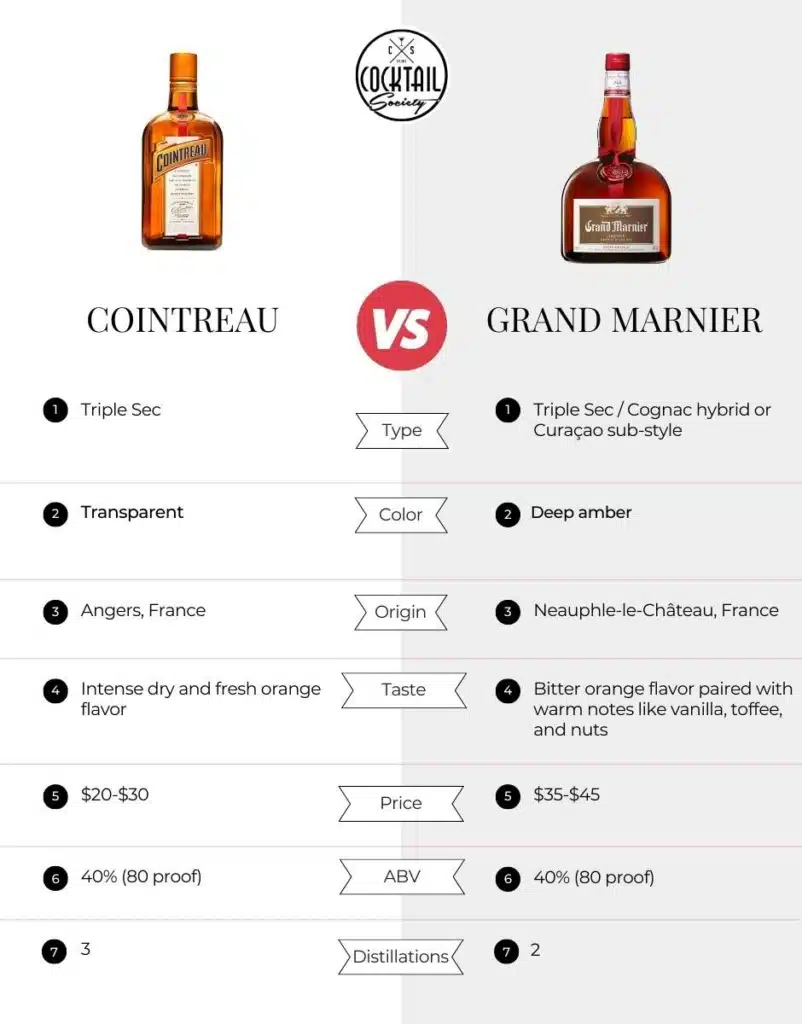
One of the most common alternatives to Cointreau is Grand Marnier cordon rouge. The biggest difference between the two orange liqueurs is that Cointreau is a true Triple Sec and Grand Marnier is a blend of Cognac and orange liqueur.
Flavorwise, Cointreau is fresher, brighter, and more intense, whereas Grand Marnier has a richer yet more mellow flavor profile. Check out how Cointreau compares to Grand Marnier in our in-depth article about the differences of these two orange liqueurs.
Cointreau is a premium product within the category of Triple Sec liqueurs. Triple Sec is a generic term for an orange-flavored liqueur that usually contains between 15% and 40% ABV. It's made with sun-dried bitter and sweet orange peels that get macerated for at least 24 hours before being distilled.
Also, Triple Sec needs to get distilled three times, a so-called triple distillation process. "Sec" is a French term translating to "dry", but it's also the word for "distilled". So the Triple Sec literally means triple-distilled.
If you want to know more about this category of orange liqueur in general, you can read about Triple Sec here.
Curaçao and Triple Sec are closely related. Curaçao is, in fact, the forerunner of Triple Sec and, therefore, of Cointreau. So, the French version was inspired by the orange liqueur invented by the Dutch. In terms of flavor, both types are similar but not the same. Still, you can substitute one for the other. If you want to know more about the differences and similarities, read this comparison of Triple Sec and Curaçao.
Curaçao got its name from the Caribbean island of Curaçao, part of the ABC islands. Spanish sailors found the island and brought oranges with them because they wanted to make use of the Caribbean sun.
Fast forward a little, the Dutch East Indian Company took possession of Curaçao and, of course, the oranges. They quickly discovered that the fruits were way too bitter and inedible.
However, the oranges were intensely fragrant, and the Dutch started making liqueur with the peels from the fruits. This liqueur is Curaçao, with its most popular representative being Blue Curaçao.
Cointreau is part of countless drinks. Many of them are among the most popular cocktails of our time. Drinks like the Margarita, Mai Tai, Cosmopolitan, or the Long Island Ice Tea all contain the orange-flavored liqueur.
And the reason for this is simple. Cointreau brings a lot of things to your cocktails: It is bitter, sweet, fresh, citrusy, and contains quite some alcohol. A perfect ingredient to balance drinks, especially when combined with another citrus component like lemon or lime juice.
I personally love Cointreau. It's not cheap, but it works exceptionally well in mixed drinks. It certainly is an essential cocktail ingredient for every home bar.
Now, if you want more inspiration, here's a list of our favorite cocktails made with Cointreau.
Cointreau is a premium Triple Sec brand and one of the most-used Triple Sec in cocktails. Due to its high alcohol content and low amount of sugar, it has an intense and rather dry flavor profile. It's best when served chilled as an aperitif, digestif, or part of a cocktail.
Together with the Daiquiri and the Mojito, the Cuba Libre is in the top three of the most influential cocktails of our time of Cuban origin.
Translated, Cuba Libre means free Cuba. A popularized term after the Spanish-American War, celebrating liberation and independence from Spain. So why was this simple mix of rum, Coke, and lime named after this significant event?
Quick Facts Cuba Libre Drink
Our recipe shows you what it takes to make a proper, traditional Cuban Cuba Libre. - And read on to learn all secrets behind one of the purportedly easiest-to-make and basic cocktails available on today's bar menus.
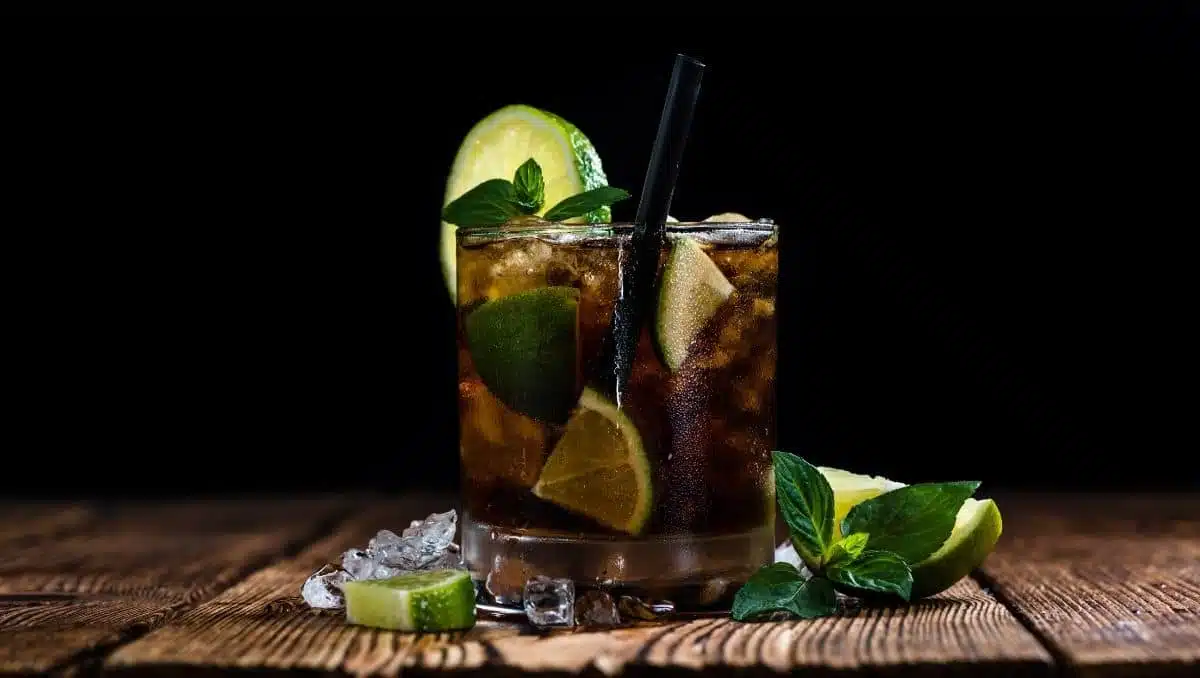
For a long time, Bacardi claimed to be the leading brand when it came to making the perfect Cuba Libre. But naturally, that was more of a clever and brilliant marketing move than anything else.
Interesting side fact: In the US, Cuban goods are pretty much unavailable, so how come you can get Bacardi and Havana there? Find the entire story in our article about Havana Club.
For Coke, you usually want to go with the original ingredient, Coca-Cola. To make your Cuba Libre perfect, I recommend using the Mexican version - if you can get a hand on it.
Mexican Coca-Cola is sweetened with sugarcane - instead of, for instance, corn syrup in the US. It blends particularly well with rum since that is also a sugar cane product. You can get this Coke in Latin American supermarkets or online.
Since Cuba does not import Coca-Cola, they came up with a beverage called TuKola, which has been the standard choice in the Cuban version of the Cuba Libre Drink. This Cuban Coke is super tasty and would pose serious competition to Coca-Cola if it was available outside of Cuba. Try it if you ever have the chance.
Opinions are divided regarding how much lime juice a Cuba Libre needs. Some prefer just a splash of 5ml (1/6 oz), others -like us- prefer a more citrus-forward taste and 15ml (1/2 oz) of freshly squeezed lime juice.
Lime is what balances the crisp, alcoholic taste of rum and the sweetness of Coke. To us, it's the ingredient that makes all the difference. If you like your drinks sour, you can even increase the amount of lime juice beyond 0.5 oz.
When Cuba won independence from Spain in 1898 with the help of the Americans, Bacardi Rum and Coca-Cola were available everywhere in Cuba.
Therefore, it was an obvious choice to mix the two elements. Lime was readily available, and that's how the recipe and the name came up. All quite simple and straightforward. Only later should things become more complicated...
After having helped to free Cuba from the Spanish regime, the Americans took over as the new country controlling and regulating the island. When they arrived in Cuba, they brought common American goods, among them Coca-Cola.
As the story goes, an American soldier mixed the sweet American soda with Cuban Rum and a splash of lime juice.
Initially, Cubans celebrated their new "freedom" with the slogan Cuba Libre. Since the Americans were associated with the liberation of Cuba, it only made sense to name the drink (made with an American product and invented by an American) accordingly.
Well, we all know that things turned sour quickly, and the situation didn't age well. When the relationship between Cuba and the US became more complicated, the supply of Coca-Cola stopped. Thus, Cuba had to make its own version of the lemonade.
Still, this short-lived alliance paved the way for some prominent cocktail creations. The most famous ones are the Daiquiri and the Cuba Libre.
Another drink right out of the heart of the Caribbean island that recently gained traction is the Canchanchara, a blend of aguardiente, honey, and lime. It has its roots in the small town of Trinidad, Cuba.
For more cocktails with Coke, check out these recipes:
Deep in the German Schwarzwald lies the cradle of Monkey 47. It is a rich and complex Gin that has not only convinced Germans but Gin lovers all across the globe. Each year, the brand releases a strictly limited Distiller's Cut that is either produced differently or adds another ingredient to the list of botanicals.
In 2021, for the limited edition, they added a flower called Scarlet Monarda to the mix. Let's see how it affects the aroma and flavor of the gin.
What is it? | Facts | The secret ingredient | Tasting notes | Use in cocktails | How it's produced | How to buy it | FAQs
Monkey 47 is a seriously complex Gin. So it's quite interesting to see that just by adding one ingredient to 47 others, you can alter the aroma and taste of the spirit.
Overall, I find the Monkey 47 exceptionally well-balanced and crafted, which results in a unique taste. A refreshing mix of citrus, fresh herbs, and a spicy top note
The 2021 Distiller's cut is a special and strictly limited edition of Monkey 47 gin flavored with Scarlet Monarda on top of the 47 regular botanicals.
In general, the Distillers Cut is one of the many special editions of Monkey 47 and is produced and sold once per year only. It all started with the first one in 2010. Back then, only 2,500 bottles of the limited version were available for sale.
In response to the great demand, Monkey 47 decided in 2016 to increase the number to 4,000 bottles and give more customers a chance to get their hands on this sought-after rarity. -I was among those lucky ones in 2021.
For the 2021 Distiller's Cut, they went with a new and long-kept secret element: The 48th botanical, or the "species rara" as Monkey fondly calls it, is Scarlet Monarda.
As exotic as this botanical might sound, the Monarda Didyma (its Latin name) used in this year's Distiller's cut actually grows on a farmstead just around the corner of the Monkey 47 distillery.
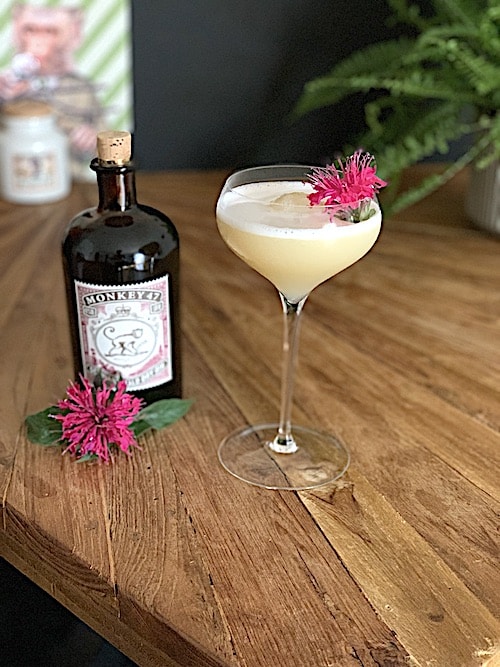
The herb, also known as bee balm or Oswego tea, comes from the lower parts of the Swabian Jura mountains. And it also grows in large parts of the US, mainly in the Northeast.
The aroma of Scarlet Monarda is unique and distinct, reminding me of a mix of mint, sage, and oregano, with the petals having a slightly milder scent.
The spiciness of the Gin goes well with notes of herbs and citrus, creating a significantly different taste that's hard to compare but absolutely tasty.
It's a fantastic Gin best sipped neat or in a Gin & Tonic. But it also works great in classic Gin cocktails (Link) adding a nice spicy note to the drinks like a Bees Knees, Hanky Panky, or a Gin Sour.
When it comes to special or limited editions of spirits, it's always fun to find out how they compare to the regular product.
I already mentioned Scarlet Monarda joined the list of ingredients but not how it's incorporated. The Monarda petals get macerated together with the 47 traditional botanicals. After the maceration process, the result is distilled twice before it's left to age for three months.
Fresh spring water from the Black Forest is then added before bottling to bring the Gin down to the desired ABV.
The Monkey 47 Distiller's cut is strictly limited. In 2021, there were two different batches.
In the US, they released 4,000 bottles of the smaller 0,375l version. And another 4,000 bottles of the 0,5l version were available worldwide.
If you wanted to get a Monkey 47 Distiller's Cut, you had to be fast. As usual, the Distiller's Cut sold out quickly, and you won't get a second chance. Usually, they do a raffle on their website to make the process fairer.
There are some shops that sell the bottle even now, long after the raffle. The prices are high, though, as these are highly sought-after collectibles.
Generally, if you're interested in getting your hands on Monkey's special releases, follow their Instagram. They promote their upcoming special editions well ahead, giving you enough time to register for the raffles. - Note: the raffle gives the option to purchase a bottle. So, if you're among the lucky ones, you won't get it for free.
Corpse Revivers have a long tradition, as you can already guess from the #2 in the name. Since the mid-1800s, Corpse Revivers have been on bar menus across the USA. And the Corpse Reviver No. 2 is one delicious version of it.
The Corpse Reviver #2 widely gets accepted as the best-tasting drink amongst the Corpse Reviver drinks. It's a perfectly balanced yet still quite boozy cocktail. And an evergreen that surely won't go out of fashion anytime soon.
Although you would expect a drink meant to cure a hangover is low in ABV to non-alcoholic, the Corpse Reviver No. 2 is far from that.
The original cocktail contains Gin, orange liqueur, and Kina Lillet - a French fortified wine, similar to Vermouth. And to create a rounded and perfectly balanced drink, it also includes zesty fresh lemon juice and a dash of Absinthe.

Basically, the Corpse Reviver No. 2 is a classic sour cocktail based on Gin. A mix supposed to be so bold and boozy it could bring you back to life no matter how poor shape you are in. The drink became famous because Harry Craddock mentioned it in his Savoy Cocktail Book.
Craddock recommended the Corpse Reviver No. 2 cocktail "to be taken before 11 a.m., or whenever steam and energy are needed". -A drink you can order anytime to get your groove on.
The original recipe asked for equal parts Gin, orange liqueur, Kina Lillet, lemon juice, and Absinthe. A simple Dry Gin is the best type of Gin for this drink. For the orange liqueur, I like to use Cointreau. So far, so easy. Now, we're getting to the tricky part.
Kina Lillet is no longer available, so bartenders started to replace it with Lillet Blanc. This choice is obvious, considering that producers of Lillet themselves replaced Kina Lillet with Lillet Blanc.
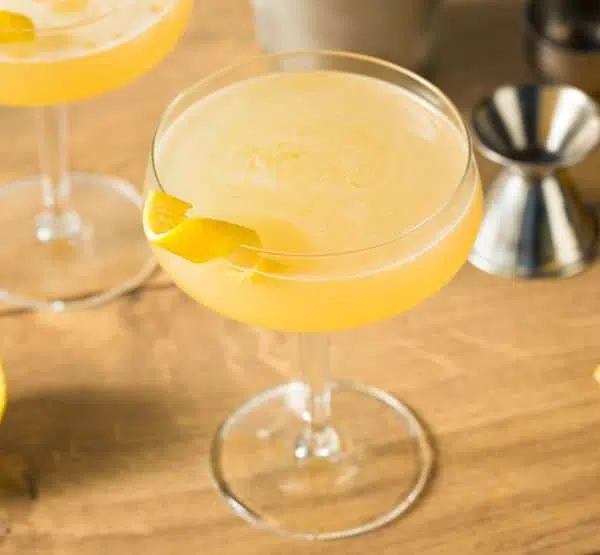
But there's a problem with this: Lillet Blanc is significantly sweeter than the traditional Kina Lillet. Viewed isolated, that would not be such a big deal.
However, the additional sweetness affects the taste notably when used in a cocktail. It's definitely going to be different from what you originally intended.
Therefore, if Lillet Blanc is too sweet for your palate, try Cocchi Americano instead. Cocchi Americano is a dry Italian Vermouth. It is used in many cocktail recipes and closer to the taste of Kina Lillet.
The known part of the history of the Corpse Reviver started in the 1870s. Quite possibly, the general formula has been around for longer.
Back in 1871, a recipe called Corpse Reviver got published in the "Gentleman's Table Guide" written by Ricket and Thomas. The drink consisted of one part Brandy, one part Maraschino liqueur, and two dashes of cocktail bitters.
As you can see, that is far from the ingredients featured in today's Corpse Reviver No. 2. And subsequently, other recipes were published in 1875 and 1903 under the name Corpse Reviver or Criterion Reviver.

It wasn't until the Savoy Cocktail Book, published in 1930, that these Corpse Reviver drinks gained popularity. And sure enough, this popular cocktail book did include a Corpse Reviver No.1 and a Corpse Reviver No. 2.
The first version, or Corpse Reviver No. 1, is closer to the initial recipe from 1871. It asked for two parts of Cognac, one part Calvados, and one part Italian Vermouth. The second recipe pretty much was what we know now as Corpse Reviver No. 2.
Like many Prohibition-era cocktails, the Corpse Reviver No. 2 faded into obscurity over the decades. It was only revived during the 80s when bartenders looked to history for inspiration.
As I mentioned, there also is a Corpse Reviver #1. It contains two parts Cognac, one part Calvados, and one part Sweet Vermouth.
If you get this drink without ice, it may be diluted with a splash of water. If you get it over ice, that will make for enough dilution, so adding water becomes superfluous.
Also, for the Corpse Reviver #2, there's an alternate recipe called the Corpse Reviver #2A. This slightly adjusted formula has sprung out of the mind of the famous Trader Vic, inventor of the Mai Tai cocktail.
When Kina Lillet was no longer available, he replaced it with Swedish Punsch. The drink wasn't named "2A" initially. Bars started to use this naming to distinguish between the classic and the modified recipe.
Other popular Corpse Reviver drinks are, for instance, the Criterion Reviver and the Cafe Royal Reviver. All of these Reviver drinks follow very different recipes that oftentimes appear rather unrelated.
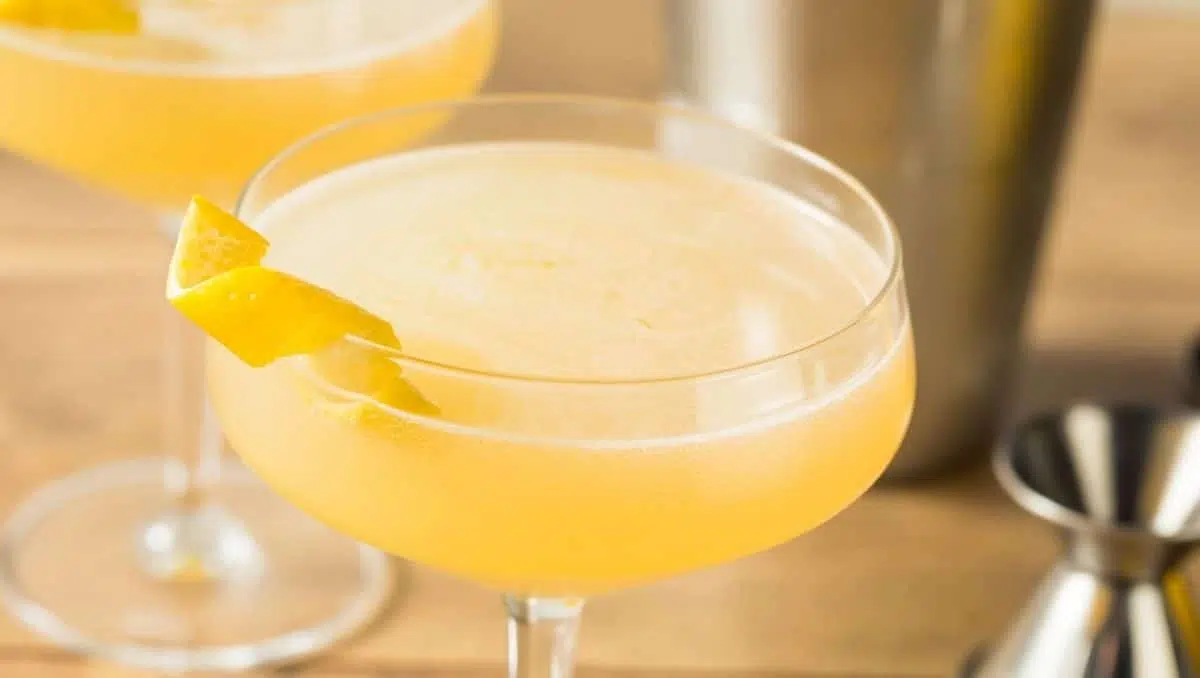
The Grasshopper cocktail is yet another creation from the French Quarter of New Orleans, in line with classics like the Sazerac, Ramos Gin Fizz, and the Vieux Carré.
The Grasshopper is a sweet and minty drink, commonly consumed as an after-dinner drink. -A splendid mix of Creme de Menthe, Creme de Cacao, and heavy cream.
And it's due to the sweetness that this drink is predominantly a favorite of the younger folks not used to the harsh notes of alcohol.
Today, the drink sometimes comes across as a little outdated. But it was very famous all over the country during the 1950s and 60s. Especially in the Southern part of the United States, the drink was widely popular.
For making a Grasshopper cocktail, you need Creme de Menthe, white Creme de Cacao, and heavy cream. And a bit of chocolate shaving for the top.
I prefer dark chocolate over milk chocolate because it's less sweet and goes well with the minty flavor of the drink. And while heavy cream should be widely known, Creme de Menthe and Creme de Cacao are not part of the essential cocktail ingredients of an average home bar.
As you might have guessed, Crème de Menthe is responsible for the green color of the Grasshopper cocktail. It has a sweet peppermint flavor. But despite the name, there's no cream involved here.
It is a Corsican-mint-infused grain liqueur with an alcohol content of 25%. It's also available colorless -white creme de menthe-, but the taste of both versions is the same.
That comes in handy for drinks like the Stinger cocktail and some other popular Crème de Menthe cocktails, where you want the peppermint flavor without the green color.
Creme de Cacao also isn't as creamy as it sounds. Just like Creme de Menthe, it's a flavored liqueur. And it's available in dark and in a see-through version, the white Creme the Cacao. And the latter is what we need for the Grasshopper as the dark version would spoil the grasshoppy green color.
Creme de Cacao tastes like milk chocolate and usually is scented with a hint of vanilla. The dark Creme de Cacao is what you would use in a Brandy Alexander to achieve the typical chocolaty look.
And if you wondered what the heavy cream is for, with all the other creamy components, now it's probably clear. With neither Creme de Menthe nor Creme de Cacao being creamy at all, you need the heavy cream for the Grasshopper's smooth and creamy texture.
New Orleans is famous for many different cocktails. And while the Grasshopper cocktail is not one of the most iconic drinks from the "Big Easy", it still is a classic. And its story is tightly knit to a restaurant with the name Tujague.
The restaurant was founded in 1856 by Guillaume and Marie Tujague. Yet, after after they successfully managed the establishment for more than 55 years, they sold it to Philibert Guichet. And that Mr. Guichet is also the one that brought the famous Grasshopper to Tujague's menu.
Guichet originally invented the Grasshopper for a cocktail competition in New York. And although the Grasshopper drink only won 2nd place in this competition, Guichet managed to make it a true classic by bringing it to his restaurant menu.
Still, the exact time when he invented the drink isn't known. For a long time, it was a common belief it is from the 1920s. However, according to historian Poppy Tooker, there is written evidence of the drink having been served at Tujague's as early as 1919. That puts the birth date of the green mint cocktail somewhere in the 1910s.
And until today, Tujague's in New Orleans is serving hundreds of Grasshoppers per week.
Unquestionably, the Grasshopper drink got named after its bright and intense green color. But it's not only popular because of its visual characteristics. The sweet cocktail combines one of the most classic dessert flavor combinations - Mint & chocolate.
The thing that makes this drink such a brilliant dessert cocktail is the low amount of alcohol. Creme de Menthe and Creme de Cacao only contain around 25% ABV each. And Heavy cream is obviously non-alcoholic.
If you mix the drink with the traditional equal parts approach, the result is a cocktail of approximately 15% ABV (calculating in the dilution). That's the equivalent of a heavy red wine.
If you use a bit more heavy cream, the result will become even less alcoholic, like we do in our recipe below. That makes the drink an even better delicious dessert replacement that won't leave your guests unable to drive home after dinner. So grab your cocktail shaker, and make some Grasshopper cocktails.

You decided to throw this year's Halloween party and have come here for spooky Halloween cocktails to make at home?
Also, do you feel the worn-out Wodka-Jelly shots from the 80s are nothing to get too excited about? Then you're at the right place, as it's the perfect time to get a little fancy.
Here's a list of our favorite Halloween cocktails. They are spooky, mostly easy to make, and delicious. We also linked Halloween glassware for you to give your cocktails the right look.
This drink by Katie (@garnish_girl) one is for the coffee lovers, and it's super easy to do a non-alcoholic version for younger guests. Just replace the alcohol and coffee part with a hot chocolate, et voila.
Difficulty: medium
Servings: 1
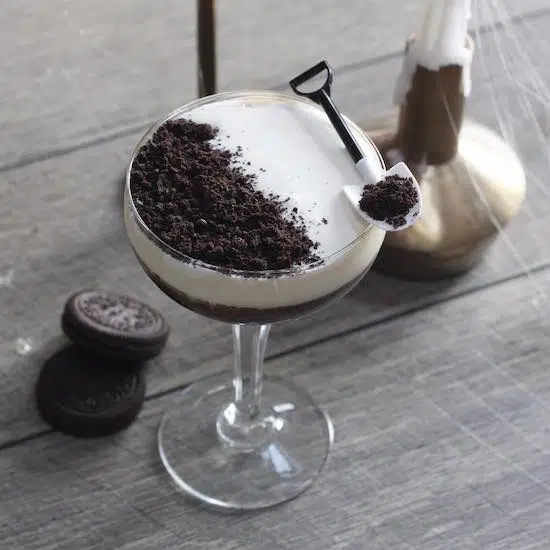
Ingredients
1.5 oz Oreo infused Vodka
0.75 oz coffee liqueur
1 oz espresso
0.25 oz vanilla simple syrup
vanilla whipped cream
miniature shovel as garnish
To infuse your Vodka with Oreo flavor, take one cookie per 1.5 oz, add it to the Vodka the day before and let it sit overnight. Then mesh strain it after 24h and run the spirit through a coffee filter to remove tiny bits and pieces of oreo.
To mix the cocktail: Shake, strain, and top with (lightly sweetened) vanilla whipped cream and crumbled Oreos. The amount of whipped cream depends on the glass you use. I recommend keeping it below 0.5 inch/ 1cm.
This Halloween-themed Mai Tai literally is a bloody good and fun version of the Mai Tai. It is fruity, boozy, and fun to make.
Difficulty: medium
Servings: 1
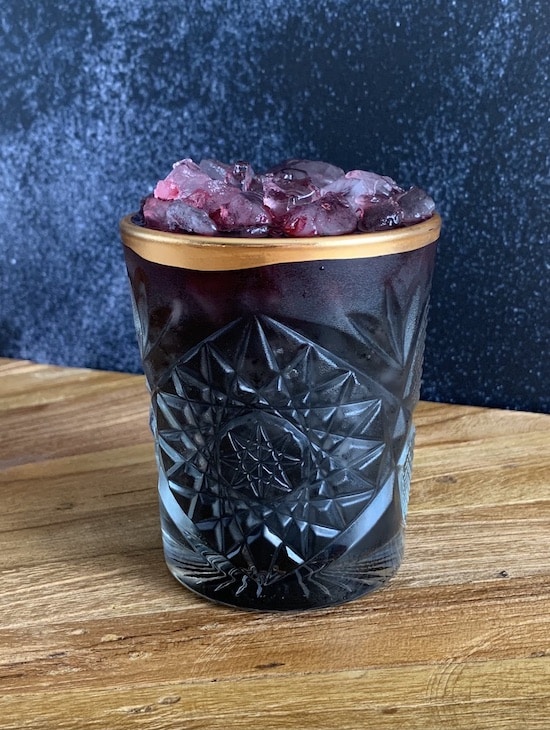
Ingredients
1.5 oz White Rum
0.75 oz Cointreau
0.75 oz Freshly squeezed lime juice
0.5 oz Orgeat
0.75 oz Dark rum
A dash of squid ink -or alternatively 1 tbsp. of activated charcoal, if you have reservations about squid ink
Dried Hibiscus flowers
Pour Dark Rum into a glass, add hibiscus flowers (2 - 3 per oz), and let it sit for a few hours until the Rum turns dark and bloody red. You can do that for all servings at once. Use a little more Rum, as the flowers will soak up some of the Rum.
Add White Rum, lime juice, Cointreau, squid ink (or charcoal), and lots of crushed ice into your shaker. Give all a good shake and pour the mixture with the ice into your glass.
Be careful not to fill the glass to the rim. You will need a little space for the bloody Rum float.
Place enough extra crushed ice on top so it covers the surface nicely. Then slowly pour the hibiscus-favored Rum on top using your bar spoon to keep it on top. Enjoy!
The Vampira's Attic from Valérie (@mydigitalkitchen) is a refreshingly fruity and slightly tangy version of a Halloween cocktail from mydigitalkitchen.
And the dry ice adds the perfect spooky touch - if you don't want to go through the trouble of using dry ice, you can also go for a Halloween-themed glass instead.
Difficulty: medium to hard
Servings: 1
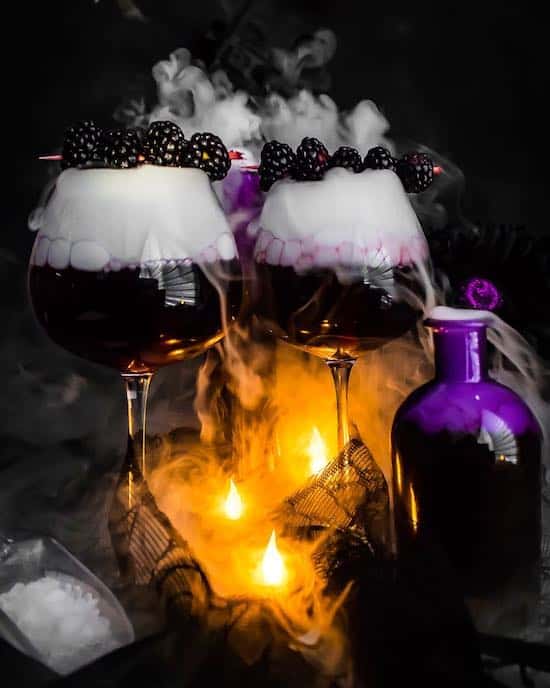
Ingredients
8 oz grape/currant juice
1 oz black Vodka - alternatively, regular Vodka will work, too
0.5 oz lemon juice
A splash of club soda
Dry Ice - where to get that from
Blackberries for garnish
Mix all ingredients expect the soda and the dry ice in a cocktail shaker with plenty of ice. Strain it into the glass and add a splash of soda before adding the skewered blackberries and the dry ice.
Important note when using dry ice: Make sure the dry ice fully dissolves before drinking the cocktail. That means you need to wait until the foggy effect stops. Otherwise, you risk frostbite.
Also, don't touch the dry ice with bare hands. Always use thick gloves or a spoon.
This cocktail from Monica is a Halloween-inspired riff on the classic French 75, replacing the traditional Gin and lemon juice with Gibson's Finest Whisky Venerable, Dillion's Haskap Liqueur, and fresh pomegranate juice.
You can find more info about this creation at liqculture.
Difficulty: easy
Servings: 1

Ingredients
3/4 oz Gibson's Finest Whisky Venerable
3/4 oz Dillion's Haskap Liqueur
3/4 oz pomegranate juice
one dash simply syrup
2 oz Sparkling Wine
Add Whiskey, Liqueur, pomegranate juice, and syrup into your shaker. Fill it with ice and give it a good shake. Strain the mix into your Halloween flute glass and top it with sparkling wine.
This fun cocktail by Emrah (@lelabbo)s inspired by Tim Burton's famous movie A Nightmare before Christmas. It's a brilliant way to bring some 90s nostalgia with a modern twist to your Halloween party.
Difficulty: medium
Servings: 1
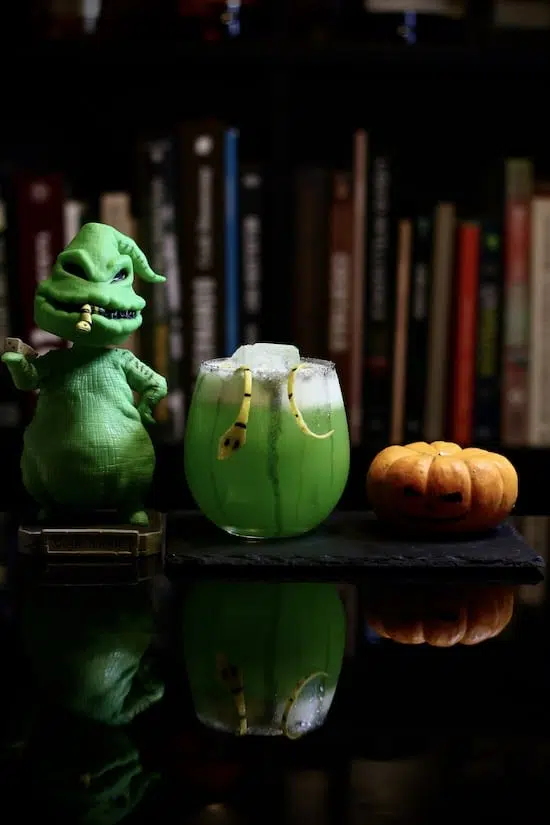
Ingredients
1.5 oz Tequila Blanco
0.75 oz Mezcal
0.75 oz Grand Marnier
1.5 oz lime juice
0.75 oz tarragon syrup
one chili pepper
one egg white
carbon salt
lemon peel
First, coat the rim of your glass with activated carbon salt and fill it with ice.
Then add a piece of chili pepper, Tequila, Mezcal, Grand Marnier, lime juice, tarragon syrup, and the egg white into your shaker and dry shake first.
That means without ice at first, and then a second time with ice. That way, you'll get a better foam. If you prefer a vegan option, you can replace the egg white with Aquafaba.
Now, carefully double strain into your glass and garnish with a lemon peel snake.
If you want to spice things up a little more, take two chili bits instead of one and muddle them before adding the other ingredients.
A classic White Russian with a Halloween twist to it. It's something for you if you prefer cocktails that are a little more on the sweeter side - it's still well-balanced, though.
Difficulty: medium
Servings: 1

Ingredients
2 oz Vodka
1 oz Kahlua
1 oz heavy cream
0.25 oz pumpkin spice syrup
pumpkin pie spice or cinnamon for garnish
Add Vodka, Kahlua, pumpkin-spiced syrup, and plenty of ice into your shaker, then shake until the mix is well-chilled. Strain the mixture in your glass or cup. Now pour the cream carefully via a spoon on top.
Using a spoon helps the cream to stay on top for the typical White Russian look.
Now sprinkle some cinnamon on top. - If you want to garnish your drink with a spooky face, slightly froth the cream before pouring it in.
If you want to do your own syrup, you can go with 9oz water, 9 oz brown sugar, a cinnamon stick, the pulp from one vanilla bean, three cloves, and a tablespoon of pumpkin pie spice.
Strain everything through a coffee filter and let it cool down before using it in your cocktail. For detailed instructions on how to make syrup, read here.
The origin of Halloween is in Mexico, where it is called "Día de Los Muertos" and celebrates the dead. And how could this be done any better than by mixing two iconic Mexican Agave spirits like Brenton (@cheerstohappyhour) does in his black Margarita?
Difficulty: easy
Servings: 1
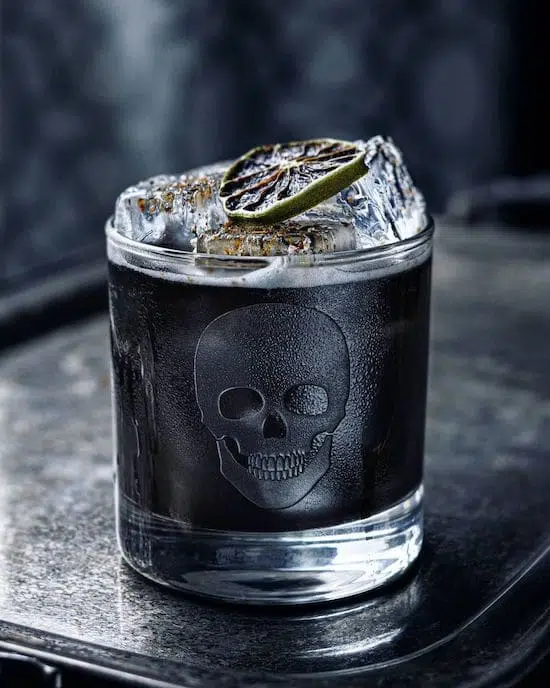
Ingredients
1.5 oz Tequila Tromba
0.5 oz Mezcal Aqua Santa
1 oz of lime juice
0.5 oz agave nectar
Barspoon of activated charcoal
Garnish: Tajin and dehydrated lime wheel
Shake all ingredients with ice and strain into a rock glass with fresh ice.